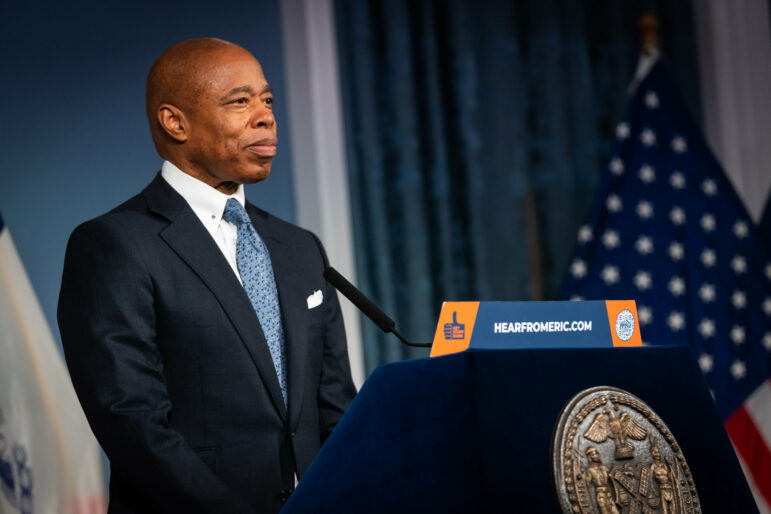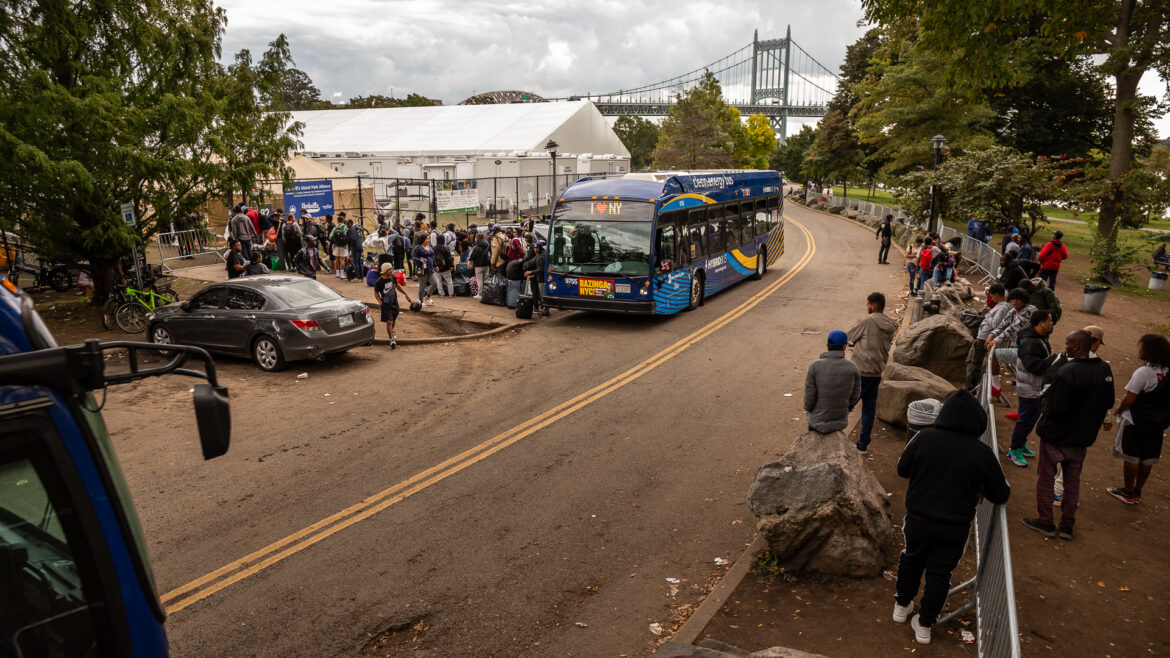“Instead of 100,000 migrants by mid-2024, we expect to care for 80,000 by June and 90,000 by the end of the year,” Mayor Eric Adams said while unveiling his budget Tuesday, saying a combination of strict limits on immigrant shelter stays and “reticketing” efforts to move immigrants to locations outside the city helped drive that estimate down.

Ed Reed/Mayoral Photography Office.
Mayor Eric Adams unveiling his Fiscal Year 2025 budget proposal on Tuesday, Jan. 16.Toward the end of last year, the New York City Office of Management and Budget (OMB) projected a gap of $7.1 billion in the fiscal year that will begin on July 1—driven by $6.1 billion the city expected it would be spending on sheltering newly-arrived immigrants.
But Mayor Eric Adams’ proposed $109.4 billion budget announced Tuesday closed that gap, as is required by law, thanks in part to higher-than-expected tax revenue projections—including an extra $1.6 billion for the coming fiscal year—and a freshly reduced cost projection for those new arrivals.
“Last August I stood here and told you that we were projecting that more than 100,000 individuals would be in our city’s care by mid-2024, and that cost would exceed $12 billion over three fiscal years if circumstances did not change,” Adams said in a video address from City Hall Tuesday afternoon.
But a combination of strict limits on immigrant shelter stays, “reticketing” efforts to move immigrants to locations outside the city and additional resettlement case management have helped drive that estimate down, he continued.
“Instead of 100,000 migrants by mid-2024, we expect to care for 80,000 by June and 90,000 by the end of the year,” Adams said. “This is a $1.7 billion change.”
City Hall credited other planned efforts to lower spending on immigrants, including negotiating rates and reducing staffing at emergency shelters and moving smaller contracts to nonprofit operators, though details remain sparse. The goal is to reduce the nightly shelter cost from $396 per household to $352, the administration said.
The updated cost projection is $10.6 billion over three years, including lower estimates for the current and coming fiscal years—$4.2 billion and $4.9 billion respectively.
The mayor went on Tuesday to celebrate the rollback of other budget cuts announced last year, including for NYPD recruitment, sanitation and parks maintenance and the city’s Community Schools program. Those changes restored about $200 million of the $7 billion in City Hall’s spending slashes ordered for this month and November, according to Budget Director Jacques Jiha.
“We looked over where the money we were able to save [was], we were able to restore some of the cuts, particularly around public safety, because I know how important that is,” Adams said at a press conference Tuesday afternoon.
But the mayor’s critics were not impressed, accusing him of rolling back cuts that weren’t necessary in the first place.
“Setting your own house on fire and then putting it out doesn’t make you a hero,” Ana María Archila and Jasmine Gripper of the New York Working Families Party said in a statement Tuesday, accusing Adams of having “scapegoated” new immigrant arrivals.
Also on Tuesday, Gov. Kathy Hochul presented highlights from her proposed $233 billion budget for Fiscal Year 2025, revealing she plans to allocate $2.4 billion for costs associated with newly-arrived immigrants statewide, including $500 million from the state’s reserves. The new funding builds on $1.9 billion allocated for the current fiscal year.
Reserves, or funds set aside for emergencies, have made up about 15 percent of recent state budgets, according to the governor. “It’s important for me, for the economic health of our state, to have that,” she said in her address.
But a recent analysis of interest earnings showed the state could send $500 million to the city to cover the cost of thousands of migrant shelter beds in tent facilities while still maintaining about $22 billion in reserves, Hochul added. In doing so, the state is absorbing the cost of sheltering migrants at Randall’s Island and Creedmoor in Queens.
“I made the decision that we can set aside $500 million to help cover the costs of these congregate settings that otherwise the city would have to do,” Hochul said. “This is how we can help.”

Adi Talwar
The city’s tent shelter complex at Randall’s Island, pictured here in October 2023.About $1.1 billion will be available to New York City through reimbursements, according to State Budget Director Blake Washington. Another $650 million will fund congregate tent shelters—including Floyd Bennett Field, for families—and $550 million will go toward non-sheltering costs, like case management and National Guard support.
Numbers could evolve during negotiations with the State Legislature ahead of an April budget deadline.
Adams said Tuesday that he had not yet fully reviewed the state funding proposal, but that it could potentially alleviate the need for the third of three rounds of planned city spending cuts in the current fiscal year, known as Programs to Eliminate the Gap, or PEGs.
“If we receive sufficient funding from the state, we will be able to cancel the April PEG savings program and avoid the possibility of service reductions in the future,” he said.
Some advocates and progressive lawmakers have urged Hochul to raise income taxes to further support immigrants. But the governor told reporters Tuesday that higher income taxes are off the table. “No income tax increase,” she said. “I’m very firm.”
Nathan Gusdorf is director of the Fiscal Policy Institute, a think tank that has encouraged increases in government spending in areas like affordable housing. He described Hochul’s reserve spending on immigrants Tuesday as “the right first step.”
Whether it will be enough is hard to say, Gusdorf added, noting that City Hall’s revenue projections have increased in the new year, while its cost projection for sheltering new arrivals has decreased. “Those trends could continue going forward,” he said.
Other budget watchers expressed concern that the mayor is celebrating the cost benefit of reducing the shelter census by way of 30- and 60-day eviction notices. There are currently 68,000 immigrants in the city’s care, officials said Tuesday, of the 168,000 who’ve arrived since spring of 2022.
But Adams has not shared data to back up his statements that people exiting shelter are on a path to self-sufficiency, critics argued.
RELATED READING: Shelter Deadlines for Immigrant Families Expire, as System Frays
“No numbers have been presented to us about how many single adults and families with children have moved into permanent homes, or how many that have been on the line at the reticketing centers were offered a shelter again, and exactly what costs were eliminated,” said Councilmember Shahana Hanif, chair of the Immigration Committee.
Hanif added that she is eager to see the results of a recently-announced audit into the shelter notice policy, by Comptroller Brad Lander.
“We really have no answers, and it’s absolutely on purpose,” she said.
Melissa Chua, co-director of the Immigrant Protection Unit at the New York Legal Assistance Group, said the shelter eviction policy only makes things harder for newly arrived immigrants, saying uprooting people every 30 or 60 days is “just adding a cruel and unnecessary element of destabilization to their lives.”
“How can you say you’re putting recently arrived immigrants on a path to self sufficiency when you’re blatantly complicating their access to mail, which they need in order to complete their work authorization or asylum applications, for example?” Chua said.
–With additional reporting by Jeanmarie Evelly
To reach the reporter behind this story, contact Emma@citylimits.org. To reach the editor, contact Jeanmarie@citylimits.org








